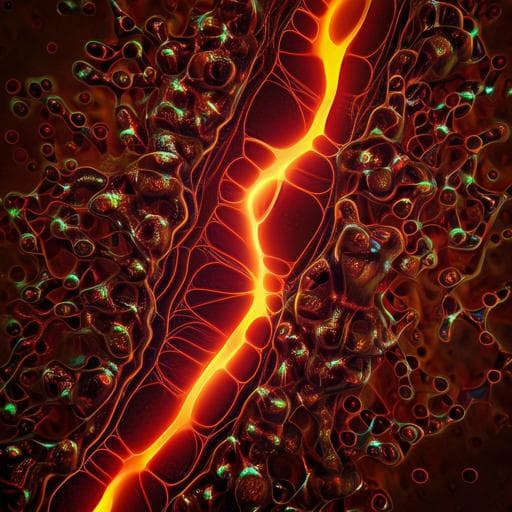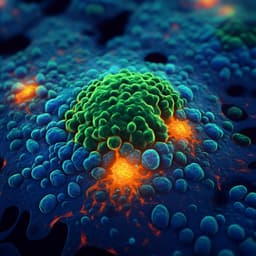
Biology
Biasing the conformation of ELMO2 reveals that myoblast fusion can be exploited to improve muscle regeneration
V. Tran, S. Nahlé, et al.
This groundbreaking research by Viviane Tran and colleagues reveals new insights into myoblast fusion, a critical process for muscle development and regeneration. By exploring the role of ELMO scaffold proteins and their influence on myoblast fusion, the study showcases potential regenerative strategies to address muscle diseases, including reversal of dystrophic features in a mouse model.
~3 min • Beginner • English
Introduction
Myoblast fusion is essential for forming multinucleated skeletal myofibers during development and regeneration. In adult muscle, satellite cells proliferate, differentiate, and fuse to repair damaged fibers; however, the full set of proteins and pathways governing fusion remains incompletely defined. Known fusogenic proteins include MYOMAKER (MYMK) and MYOMIXER (MYMX), whose mutations cause Carey-Fineman-Ziter syndrome. Limb-girdle muscular dystrophy type 2B (LGMD2B), caused by Dysferlin (DYSF) mutations, is associated with membrane repair defects and impaired myoblast fusion. RAC1 and its activator DOCK1 are part of a conserved pathway required for fusion, and the DOCK–ELMO complex is autoinhibited by intramolecular contacts. While ELMO’s role in vertebrate myogenesis had not been established, Drosophila studies suggested involvement. This study tests whether mammalian ELMO proteins are essential for myoblast fusion and whether biasing ELMO2 conformation in vivo can modulate fusion to improve regeneration and disease outcomes.
Literature Review
Prior work established RAC1 and DOCK1 as essential for vertebrate myoblast fusion via genetic inactivation studies. The ELMO–DOCK complex regulates RAC signaling and is controlled by autoinhibitory interactions; ELMO opens upon signals (e.g., small GTPases like RHOG or ARL4A) to enable RAC activation. Fusogens MYMK and MYMX are necessary for myoblast fusion, with human mutations causing Carey-Fineman-Ziter syndrome. Dysferlin (DYSF), involved in membrane repair, is linked to fusion efficiency; DYSF-null mice show smaller fibers and fusion defects. Other ferlins (e.g., MYOFERLIN) regulate membrane resealing and fusion. GPCRs BAI1/BAI3 can signal via ELMO/DOCK in fusion. Despite these insights, ELMO’s vertebrate role in myogenesis was unproven and whether modulating ELMO’s conformational state could therapeutically enhance fusion had not been tested.
Methodology
- Expression profiling: Whole-mount RNA in situ hybridization at E11.5 to assess Elmo1/2/3 expression in somites; RT-qPCR and analysis in adult tibialis anterior (TA) and primary myoblasts; assessment during C2C12 differentiation.
- Mouse genetics: Generation of Elmo2 reporter/KO first allele (Elmo2LacZ) and conditional floxed (Elmo2flox) alleles; validation by Southern blotting and immunostaining. Global deletion via Meox2Cre; muscle-lineage deletion via Myf5Cre and Pax3Cre; combination with Elmo1−/− to assess redundancy.
- Conformation-biased Elmo2 knock-in lines: RBD loss-of-function (L43A; Elmo2RBD) to reduce signaling and EID mutation (1196D; Elmo2EID) to favor open conformation and increase signaling. Validation by sequencing and protein expression levels.
- Biochemistry/biophysics: NMR spectroscopy and isothermal titration calorimetry (ITC) to measure RHOG–ELMO2 interactions for WT vs L43A mutant; binding affinity determination.
- Histology and immunohistochemistry: H&E staining for myofiber cross-sectional area (CSA); immunostaining for MHC, DESMIN, MYOD, DYSTROPHIN, PAX7; quantification of myonuclei within sarcolemma; diaphragm thickness; assessment of mitosis/apoptosis (phospho-H3, TUNEL); macrophage infiltration (F4/80).
- Muscle injury/regeneration: Cardiotoxin (CTX) injections into TA; tissue harvested at 7, 14, 21 days post-injury; repeated CTX cycles to model chronic degeneration/regeneration; CSA and nuclei per fiber quantified.
- Primary myoblast assays: Isolation via MACS; in vitro differentiation and fusion index (nuclei per MHC+ fiber); mixed-population fusion assay using PKH dyes to quantify myoblast–myotube fusion capability; time-lapse imaging to quantify migration speed/directionality.
- Transcriptomics: RNA-seq of WT and Elmo2EID primary myoblasts after 72 h differentiation; DESeq2 analysis; assessment of fusogene expression (e.g., MYMK, MYMX) and pathway enrichment.
- Disease model cross: Crossing Elmo2EID with Dysferlin-null (Dysf−/−) mice; CTX-induced regeneration assays; aging cohort (8–12 months) to quantify centrally nucleated fibers, necrosis, and fatty deposits; in vitro fusion assays of Dysf−/− and Dysf−/− Elmo2EID myoblasts.
- Statistics: Student’s t-test for two-group comparisons; p<0.05 considered significant.
Key Findings
- ELMO1 and ELMO2 redundantly control embryonic myoblast fusion: Double loss (Elmo1−/− with muscle-specific Elmo2 deletion via Myf5Cre or Pax3Cre) caused severe fusion defects (mononucleated MHC+ cells at E14.5), reduced muscle content at E16.5, and thin, unattached diaphragms; differentiation markers (DESMIN, MYOD, MHC) and apoptosis/mitosis were not altered, indicating a primary fusion defect.
- Conformational control of ELMO2 tunes fusion during development: Elmo2RBD/RBD alone showed no overt phenotype, but Elmo1−/− Elmo2RBD/RBD mice had smaller CSA and fewer myonuclei per fiber versus controls, indicating reduced developmental fusion. Elmo2EID/EID mice had larger CSA and more myonuclei per fiber, indicating increased fusion. RNA-seq of Elmo2EID myoblasts (~900 DE genes) showed no change in MYMK/MYMX expression; among 30 fusion-associated genes, PAK1, TGFBR2, and DYSF were differentially expressed.
- Biophysical validation of RBD mutation: ITC measured a Kd ~10.3 µM for RHOG binding to WT ELMO2, with no detectable binding for the L43A (RBD-defective) mutant; NMR titrations showed pronounced line broadening for WT but not L43A, confirming disrupted binding.
- Regeneration is enhanced by open ELMO2 and impaired when RBD signaling is eliminated in the absence of ELMO1: After CTX injury, Elmo1−/− Elmo2RBD/RBD mice showed reduced CSA at days 14 and 21, whereas Elmo2EID/EID mice exhibited larger regenerated fibers and increased percentage of fibers with ≥3 nuclei at days 14 and 21; early (day 7) sizes/nuclei counts were similar to WT. Macrophage infiltration (F4/80+) at day 3 was unchanged by ELMO2EID. PAX7+ satellite cell numbers were comparable across genotypes, indicating effects are due to fusion efficiency rather than stem cell pool size.
- Cell-intrinsic modulation of fusion: Primary myoblasts from Elmo1−/− Elmo2RBD/RBD mice had increased mononucleated fibers and fewer multinucleated fibers in vitro, while Elmo2EID/EID myoblasts showed the opposite (more ≥3-nuclei fibers). Mixed-population assays demonstrated enhanced myoblast–myotube fusion when the active ELMO2 form was present. Differentiation marker mRNAs and MYMK/MYMX levels were unchanged; actin organization and cell motility (speed/directionality) were not different.
- Sustained benefit without satellite cell depletion: After repeated CTX injury cycles, Elmo2EID/EID mice maintained larger fibers, suggesting preserved satellite cell pools during enhanced fusion-driven regeneration.
- Therapeutic relevance in LGMD2B model: Dysferlin-null (Dysf−/−) mice had smaller CSA after CTX injury (day 14); Dysf−/− Elmo2EID/EID mice restored CSA to WT-like levels. In aged mice (8–12 months), Dysf−/− muscles showed increased centrally nucleated fibers, necrosis, and fatty deposits; Elmo2EID expression reduced centrally nucleated and necrotic fibers but did not improve fatty deposits. In vitro, Dysf−/− Elmo2EID/EID myoblasts showed increased fusion versus Dysf−/−.
- Developmental necessity of autoinhibition: Elmo1−/− Elmo2EID/EID mice were nonviable, indicating that ELMO autoinhibition is essential during embryogenesis.
Discussion
The study addressed whether ELMO scaffold proteins are required for vertebrate myoblast fusion and whether tuning ELMO2 conformation can modulate fusion efficiency. The observed severe embryonic fusion defects upon combined loss of ELMO1 and ELMO2 establish their essential and redundant roles in primary myogenesis, aligning with conserved RAC1–DOCK–ELMO signaling. By engineering conformation-biased Elmo2 knock-in alleles, the authors showed that decreasing ELMO2’s RBD-dependent signaling reduces fusion, whereas favoring the open, active state increases fusion during development and regeneration. The enhancement occurs without altering core fusogen expression (MYMK/MYMX) or myoblast differentiation/migration, implicating downstream RAC-controlled cytoskeletal mechanisms. Transcriptomic changes (e.g., decreased TGFBR2) may contribute to pacing of fusion. Importantly, open ELMO2 improved key dystrophic features in Dysferlin-null mice (CSA recovery, reduced centrally nucleated and necrotic fibers) and rescued in vitro fusion, demonstrating therapeutic potential of augmenting fusion in disease settings characterized by impaired myoblast–myotube fusion. These findings underscore the significance of ELMO/DOCK conformational regulation in myogenesis and suggest strategies to pharmacologically bias this complex toward an active state to enhance regeneration.
Conclusion
This work demonstrates that ELMO1 and ELMO2 are essential for embryonic myoblast fusion and that genetic manipulation of ELMO2 conformation can bidirectionally control fusion during development and regeneration. Favoring the open conformation of ELMO2 increases fusion and myofiber growth, sustains regeneration through repeated injuries, and ameliorates dystrophic phenotypes in Dysferlin-null mice, establishing myoblast fusion enhancement as a viable therapeutic concept. Future research should: (1) define the precise RAC-dependent cytoskeletal mechanisms linking ELMO/DOCK to fusion pore formation; (2) identify the repertoire of ELMO/DOCK-interacting surface receptors (including potential roles of BAI1/BAI3 and additional partners) in myoblasts; (3) develop pharmacological or peptide-based approaches to stabilize the active ELMO–DOCK conformation; and (4) evaluate applicability across other muscle diseases and contexts of impaired regeneration (aging, cachexia, high-load exercise).
Limitations
- Global expression of conformation-biased ELMO2 may alter non-myogenic cell types; although macrophage infiltration after injury was unchanged, other immune or stromal effects cannot be fully excluded.
- Elmo1−/− Elmo2EID/EID embryos were nonviable, indicating that excessive RAC1 activation or loss of other ELMO functions may disrupt development; mechanisms underlying lethality remain to be clarified.
- The exact molecular linkage between ELMO/DOCK-mediated RAC signaling and the fusogenic machinery (MYMK/MYMX) is not fully elucidated; observed transcriptomic shifts (e.g., TGFBR2, DYSF) may contribute but causality requires further testing.
- While increased fusion improved CSA and reduced necrosis in Dysf−/− mice, fatty infiltration was not corrected, indicating limits to rescue of complex dystrophic pathology.
- Direct enhancement of ELMO binding to BAI1/BAI3 in the open conformation was not demonstrated; additional surface partners likely exist and remain to be identified.
Related Publications
Explore these studies to deepen your understanding of the subject.







